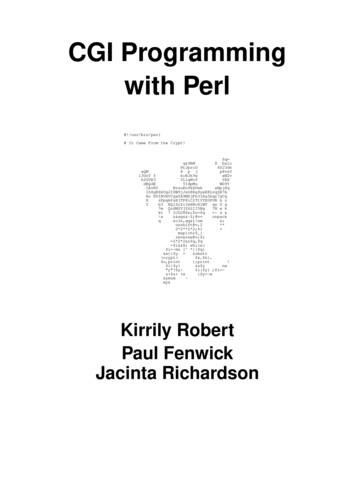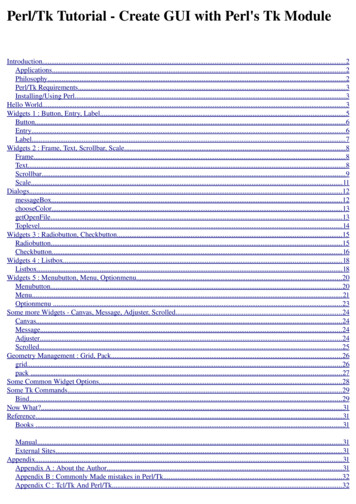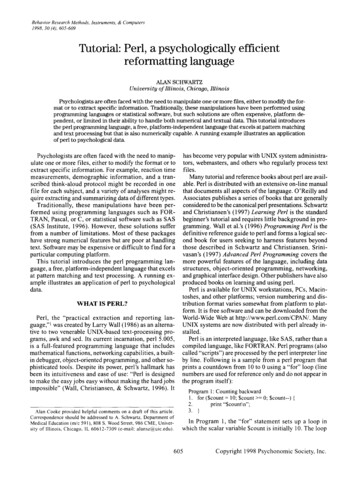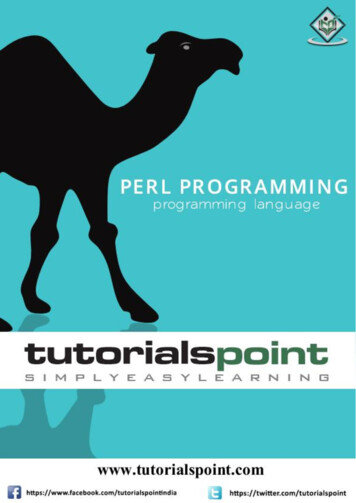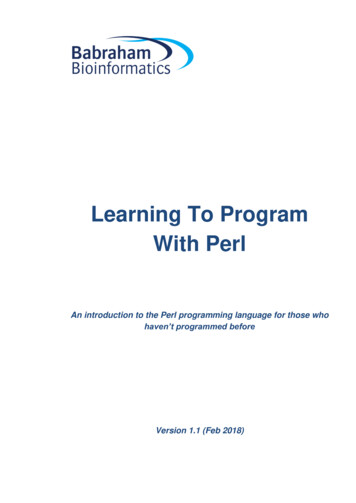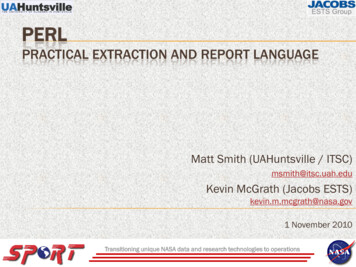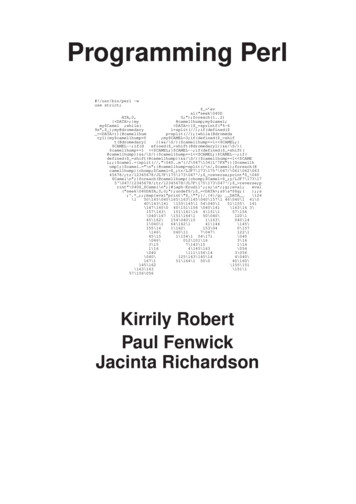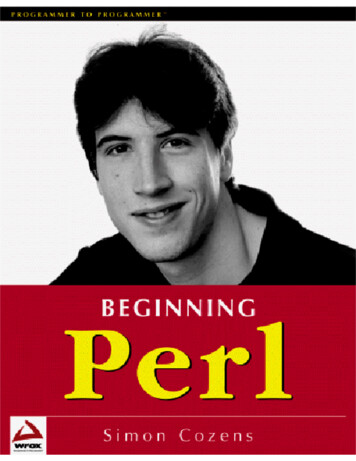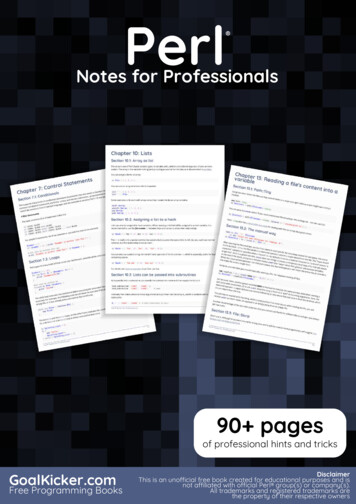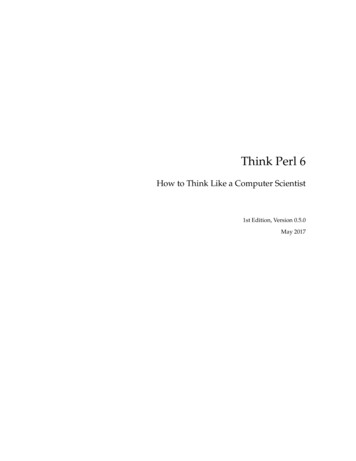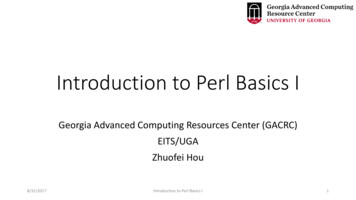
Transcription
Introduction to Perl Basics IGeorgia Advanced Computing Resources Center (GACRC)EITS/UGAZhuofei Hou8/31/2017Introduction to Perl Basics I1
Outline GACRC Perl Overview Run Perl Script Perl Data Types8/31/2017Introduction to Perl Basics I2
GACRC We are a high-performance-computing (HPC) center at UGA We provide to the UGA research and education community anadvanced computing environment: HPC computing and networking infrastructure located at the Boyd Data Center Comprehensive collection of scientific, engineering and business applications Consulting and training services http://wiki.gacrc.uga.edu (GACRC Wiki) https://wiki.gacrc.uga.edu/wiki/Getting Help (GACRC Support) http://gacrc.uga.edu (GACRC Web)8/31/2017Introduction to Perl Basics I3
Perl Overview What does “Perl” Stand for? Perl’s Brief History Tasks Perl is Good and Not Good for Perl’s “Hello, World!”8/31/2017Introduction to Perl Basics I4
What does “Perl” Stand for? Option 1: Practical Extraction and Report Language Option 2: Pathologically Eclectic Rubbish ListerWhich would you select?8/31/2017Introduction to Perl Basics I5
Perl’s Brief History In the mid-1980s, awk ran out of steam to produce large reports and Low-level C/C 8/31/2017PerlCreator: Larry WallHigh-level shell scripting, awk, grep, sedIntroduction to Perl Basics I6
Tasks Perl is Good and Not Good for Good for:Optimized for working with text (90%) and everything else (10%) Not Good for:Binary coding, GUI programing, OOP programming Easy to use, but take some time to learn8/31/2017Introduction to Perl Basics I7
Perl’s “Hello, World!”#!/usr/bin/perl# run Perl’s interpreter program perl@lines ls -l ;# outputs of command ls -l are read into @lines, @ defines arrayforeach(@lines)# for each item in array @lines{chomp;# remove tailing New Line character from each lineprint " \n" if / d/;# print the line to screen if the begins with 'd‘ (for directory)}print “Hello World!\n”;8/31/2017# print a message to screenIntroduction to Perl Basics I8
Run Perl ScriptOption 1:Option 2: Create a Perl script my script.pl: Create a Perl script my script.pl:#!/usr/bin/perl#!/usr/bin/env perlprint “Hello World!\n”;print “Hello World!\n”; Make my script.pl executable:chmod a x myScript.pl Run my script.pl:./my script.pl8/31/2017 Make my script.pl executable:chmod a x myScript.pl Run my script.pl:./my script.plIntroduction to Perl Basics I9
Run Perl ScriptOption 3:Option 4: Create a Perl script my script.pl: For a small script with several lines,print “Hello World!\n”; Run my script.pl by calling perl:perl ./my script.pl8/31/2017you can run it directly on thecommand line:perl –e ‘print “Hello World!\n”;’Introduction to Perl Basics I10
Perl Data Types Scalar Data List Data and Array Scalar and List Context8/31/2017Introduction to Perl Basics I11
Scalar Data Integer Number: 0, 2017, 255, -42, 786251429018 (you can have long integer!) Floating-Point Number: 1.25, 255.0, 7.31e2, -12e-10, 3.2E5 (default double-precision!) Single-Quoted String: ‘’, ‘fred’, ‘hello, world!\n’, ‘I didn\’t see.’ Double-Quoted String: “”, “barney”, “hello world!\n”, “coke\tsprite” Undefined Scalar Data: undef8/31/2017Introduction to Perl Basics I12
Scalar Data Scalar Variable: variableName, a scalar variable holds a scalar. Perl identifier: Made up of letters, underscores, and digits.Starts with a letter (a-z, A-Z) or underscore ( ) only! Scalar Assignment with , -, *, / (for numbers) and ., x (for strings): i 10; s1 ‘Hello'; x 10.11; s2 “World!” ; y x i;# y is 20.11 s3 s1 . “, ” . s2;# s3 is “Hello, World!” y y * 2;# y is 40.22 s3 s3 x 2;# s3 is “Hello, World!Hello, World!”Note: When you use . and x, surrounding spaces are suggested!8/31/2017Introduction to Perl Basics I13
Scalar Data Scalar Binary Assignment with , - , * , / , ** (for numbers) and . , x (for strings): i 10; s ‘Hello'; i 5;# i is 15 s . “, World!”;# s is “Hello, World!” i* 2;# i is 30 s x 2;# s is “Hello, World!Hello, World!” i- 20;# i is 10Note: When you use . and x , surrounding spaces are suggested! i** 3;# i is 10008/31/2017Introduction to Perl Basics I14
Scalar Data Auto Conversion between Numbers and Strings:Perl uses them nearly interchangeably! Numbers or Strings?It is depend on the operator that you are using! Operator Overloading i 10;# i is an integer scalar s “17”;# s is a numeric string scalar i s;# is a numeric operator result is 27 i . s;# . is a string operator result is “1017” s * 2;# * is a numeric operator results is 34 s x 2;# x is a string operator result is “1717”8/31/2017Introduction to Perl Basics I15
List Data List: A collection of scalars. List is a data type!(1, 2, 3, 4, 5);# a list of 5 integer scalars(“fred”, 3.14, 1);# a list of 1 string and 2 number scalars();# an empty list(1.100);# a list of 100 integer scalars 1, 2, 3, , 100 m 1; n 10; ( m. n);# a list of 10 integer scalars 1, 2, 3, ., 10qw / fred barney rock /# qw: quoted words, equivalent to (“fred”, “barney”, “rock”)qw / 1 2 3 4 5 /# equivalent to (“1”, “2”, “3”, “4”, “5”)Note: You can choose any punctuation character as the delimiter, e.g., qw ( ) or qw ! ! or qw # #8/31/2017Introduction to Perl Basics I16
Array Array Variable: @arrayName An array variable holds a list, just like a scalar variable holds a scalar.@arr1 (“fred”, 3.14, 1);# @arr1 holds a list of 1 string and 2 number scalars@arr2 ();# @arr2 holds an empty list@arr3 (1.100);# @arr3 holds (1, 2, 3, , 100)@arr5 qw / fred barney rock /;# @arr5 holds (“fred”, “barney”, “rock”)8/31/2017Introduction to Perl Basics I17
Array Array Indexing Range:@arr (1, 2, 3, 4, 5);Index: 0 1 2 3 4 Special Array Index: #arr 41st scalar : arr[0] 12nd scalar : arr[1] 23rd scalar : arr[2] 34th scalar : arr[3] 45th scalar : arr[4] 5 arr[1] arr[4] ?5th scalar : arr[ #arr] Quiz 1: How many items in arr? #arr or #arr 1? Quiz 2: What’s the difference?( arr0, arr1, arr2) (“fred”, 3.14, 1)( arr[0], arr[1], arr[2]) (“fred”, 3.14, 1)8/31/2017Introduction to Perl Basics Ilist assignment18
Array Adding and Deleting Elements:8/31/2017Introduction to Perl Basics I pop and push shift and unshift splice19
Array pop and push on @a (1, 2, 3, 4, 5):pop @a;# @a is (1, 2, 3, 4); 5 is discarded v pop @a;# @a is (1, 2, 3); v is 4push @a, “fred”;# @a is (1, 2, 3, “fred”)push @a, qw ( a b c );# @a is (1, 2, 3, “fred”, “a”, “b”, “c”)1234545@a shift and unshift on @a (1, 2, 3, 4, 5):shift @a;# @a is (2, 3, 4, 5); 1 is discarded v shift @a;# @a is (3, 4, 5); v is 2unshift @a, “barney”;# @a is (“barney”, 3, 4, 5)unshift @a, qw ( a b c );# @a is (“a”, “b”, “c”, “barney”, 3, 4, 5)8/31/2017Introduction to Perl Basics I123@a20
Array splice on array @a splice @a START, LEN, REPLIST (LEN and REPLIST are optional!)LEN 3@a:@a:001234512345676@b splice @a, 2, 3, REPLISTSTART 2@b:REPLIST:8/31/2017Introduction to Perl Basics I21
Array splice on @a (“fred”, “barney”, 3, 4, “tom”, 7):@b splice @a, 2, 3, qw( a b );# @a is (“fred”, “barney”, “a”, “b”, 7)# @b is (3, 4, “tom”)@b splice @a, 2, 3;# @a is (“fred”, “barney”, 7)# @b is (3, 4, “tom”)@b splice @a, 2;# @a is (“fred”, “barney”)# @b is (3, 4, “tom”, 7)Note: Each command line on this slide is operating on the initial array @a8/31/2017Introduction to Perl Basics I22
Array Common Operations: foreach sort and reverse join and split map8/31/2017Introduction to Perl Basics I23
Array foreach:@fruits qw /apple pear orange banana/;# @fruits is (“apple”, “pear”, “orange”, “banana”)foreach fruit (@fruits)# for each element, print messages to screen:{# “fruit is apple”print “fruit is fruit\n”;}# “fruit is pear”# sort and reverse:@sorted sort @fruits# @sorted is (“apple”, “banana”, “orange”, “pear”)@reversed reverse @sorted# @reversed is (“pear”, “orange”, “banana”, “apple”)8/31/2017Introduction to Perl Basics I24
Array join (array string) and split (string array):@fruits qw /apple pear orange banana/;# @fruits is (“apple”, “pear”, “orange”, “banana”) fruitString join “-”, @fruits;# fruitString is “apple-pear-orange-banana” line “John Smith:jsmith:Physics:grad”;@info split “:”, line;# @info is (“John Smith”, “jsmith”, “Physics”, “grad”) map: evaluates an EXPR for each list element and returns the list with evaluated values@negatives (-10.0);# @negatives is (-10, -9, -8, , 0)@positives map abs, @negatives;# @positives is (10, 9, 8, , 0)# abs is one of built-in numeric functions of sqrt,# log, sin, cos, tan, etc.8/31/2017Introduction to Perl Basics I25
Scalar and List Context When Perl is parsing an expression, it’s always expecting either a scalar or a list. What Perl expects is called the context of the expression. How to decide? It is the operation that decides the context, for example:Scalar Context:8/31/2017 a List Context:@fred arr[3] ( a, b) 123 push @arr, 5 10foreach i ( ) * 2.7sort “Hello” . reverse “Hello” x print Introduction to Perl Basics I26
Scalar and List Context List in Scalar Context:@a qw/1 2 fred barney/;# @a is (“1”, “2”, “fred”, “barney”) n @a;# n is 4 length of @arr #arr 1 s “Hello! ” x @a;# s is “Hello! Hello! Hello! Hello! ”@b reverse @a;# @b is (“barney”, “fred”, “2”, “1”) s reverse @a;# s is “yenrabderf21” s sort @a;# s is undef n scalar @a;# n is 4; built-in function scalar to force scalar context8/31/2017Introduction to Perl Basics I27
Scalar and List Context Scalar in List Context:Scalar value will be automatically used to make a one-element list:@a 1;@a 5 * 7;@a undef;@a ();# @a is ( 1)# @a is (35)# @a is (undef)# @a is an empty arrayforeach i (3){print “now it is i\n”;}# for each element of (3), print messages to screen:# “now it is 3”8/31/2017Introduction to Perl Basics I28
Thank You!Basics I: Perl overview, fundamental data typesBasics II: programming structures (if, unless, while, until, foreach, for), Input and OutputBasics III: Perl Regular Expression, text processing, file test and directory operation8/31/2017Introduction to Perl Basics I29
Run Perl Script Option 3: Create a Perl script my_script.pl: Run my_script.pl by calling perl: 8/31/2017 Introduction to Perl Basics I 10 print Hello World!\n; perl ./my_script.pl Option 4: For a smal
